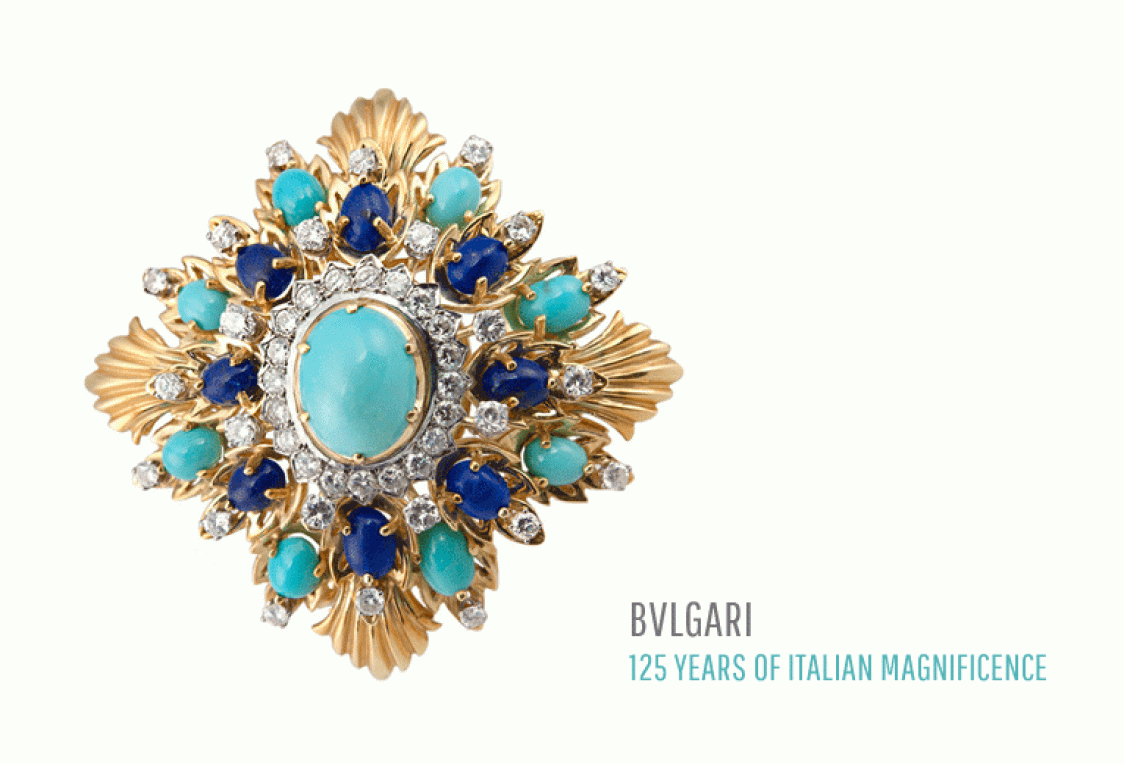The Grand Palais, Paris
Through January 12, 2011
On December 9, 2010, the Grand Palais will host the opening of a retrospective exhibition devoted to Bulgari, the Roman jewelry house that celebrated its 125th anniversary last year. Housed in the museum's nave, the exhibition has been organized under the high patronage of the Office of the President of the Italian Republic and the Italian Prime Minister's Office, and will be open to the public from December 10 through January 12, 2011. It will be the first large-scale retrospective by a jewelry house at the Grand Palais.
Entitled "125 years of Italian Magnificence," the exhibition will retrace the main chapters in Bulgari's history and the evolution of the esthetic that made the brand a driving force of the "Italian school," from the opening of the first shop on Via Sistina in 1884 through the modern day. This fascinating saga will be illustrated by more than 600 masterpieces of jewelry, watch- and clockmaking, and the decorative arts, including some one hundred exclusive pieces that will be on public display for the first time.
Certain pieces come from the collection of the Bulgari Museum, an exceptional trove of historic treasures conserved in the company's archives, while others are from private collections. Visitors will be able to admire three pieces owned by the Grimaldi family, including a necklace that belonged to Princess Grace.
The exhibition consists of eight sections arranged in chronological order. The visitor's path will start with a collection of silver objects created in the late 19th century by Sotirio Bulgari, a Greek silversmith blessed with a creative mind and keen business sense. Having come to Rome to seek his fortune, in 1884 he laid the foundation of what was to become one of the world's greatest jewelry houses.
These pieces are the only remaining examples from Bulgari's earliest days, in a style that shows classical, Ottoman and Byzantine influences. Sotirio Bulgari's migration from the Epirus region, in the final years of the Ottoman empire, to Rome, the new capital of the young country of Italy, enables us to relive the major geopolitical transformations that shaped the Mediterranean basin as it is today. During this time the Bulgari collections evolved very quickly from a Middle Eastern to a more contemporary style, and in parallel Sotirio Bulgari turned away from silver in favor of platinum and diamonds.
Next, visitors will discover a space dedicated to the designs of the 1920s and 1930s. These pieces, a series of diamond jewels inspired by the art deco movement, reflect the huge success enjoyed by the house, which was then headed by the founder's two sons, Giorgio and Costantino Bulgari.
The next room will present creations from the 1940s and 1950s, a period during which Bulgari's designs were heavily influenced by French jewelry styles.
This will be followed by a section devoted to the 1960s, a decade marked by a radical change that would prove crucial in defining the house's identity. It was during these years that Bulgari developed the distinctive features that would make the brand world-famous: bold, stylized forms, understated volumes and strikingly original color combinations defined an inimitable style, a genuine "Italian school" of jewelry that contrasted with the more classical French jewelry.
The next three rooms will house creations from the 1970s, very much influenced by pop art and praised by Andy Warhol, the 1980s, a time of daring, inventive design inspired by the Italian Renaissance, and the 1990s, characterized by unexpected combinations of materials as well as the introduction of a "ready-to-wear" concept of jewelry. These were also the years of excess and extravagance, when Grace Jones wore multiple layers of fine jewelry necklaces as a "hat," and when Tina Turner threatened to cancel a concert if no one could find her most precious good luck charm: a pair of Bulgari earrings.
The final section of the exhibition under the glass dome of the Grand Palais will feature an astonishing structure of mirrors fitted together to form an immense diamond. The continuity of the Bulgari style in the 2000s will be represented by a selection of pieces, including a stunning necklace adorned with a Burmese sapphire of more than 321 carats.
Several rooms in the exhibition offer thematic spaces devoted to decisive moments in the evolution of the Bulgari style, like the gemme nummarie, or "numismatic jewels," which feature coins from antiquity instead of precious stones—a practice that was fashionable in ancient Rome. It is interesting to note that it was a Roman jeweler, Bulgari, that made coin creations stylish again in the 20th century. A similar example is the snake motif, a Mediterranean symbol since the time of the Egyptian pharaohs and a classic image in jewelry, reinterpreted many times by Bulgari over the years. Lastly, there is the "BVLGARI" logo itself, which was inspired by ancient Roman epigraphy and transformed into a featured ornamental element in many of the house's most successful collections.
In addition to jewelry and watch designs, the retrospective will also showcase a collection of documents, many on public display for the first time, including sketches and drawings from various periods as well as a selection of photos of the artists, aristocrats and celebrities who have fallen under the charm of the house's jewelry since its founding. An entire section will be devoted to the Dolce Vita years, with portraits and quotes of the big stars of the time, sketches of jewels worn on screen by legendary actresses, and other documents illustrating the close ties between Bulgari and the art of cinema, a partnership that began in the 1940s and continues to this day.
But the real stars of this section will be the jewels themselves, spectacular creations worn by Anna Magnani, Monica Vitti, Claudia Cardinale, Sophia Loren, Romy Schneider, Ingrid Bergman and Gina Lollobrigida, as well as Empress Soraya of Persia.
A separate room will be exclusively devoted to the fabulous private collection of Elizabeth Taylor, never before seen in France. The stormy relationship between Elizabeth Taylor and Richard Burton was punctuated by a series of gifts from Bulgari, as reflected in many quotes by Richard Burton on his then-wife: "The only word she knows in Italian is 'Bulgari'," "I introduced Liz to beer and she introduced me to Bulgari."
This will be an exceptional opportunity to admire some of Bulgari's most extraordinary creations: 16 one-of-a-kind pieces of nearly inestimable value, each with its own history. One example is the diamond brooch with a central emerald of more than 18 carats offered by Burton to Taylor as an engagement gift in 1962. It was the only jewel the star wanted to wear on the day of her first wedding to Burton, on March 15, 1964. In addition to her jewels, the display will also include the David di Donatello trophy awarded to Miss Taylor in 1959 for her work in the film Suddenly Last Summer, directed by Joseph Mankiewicz.
All of the pieces in the exhibition have been carefully researched, including consultation of historical and scientific sources, by Amanda Triossi, director of the retrospective and author of the accompanying catalogue (320 pages of documentation and photographs, published by Skira). Triossi, who manages the archives of the house of Bulgari as well as its Vintage collection since 1997, has also authored two monographs (1995 and 2007) dedicated to the house's history.
Francesco Trapani, CEO of the Bulgari Group, comments: "The opportunity of exhibiting at the Grand Palais, in Paris the immense patrimony of precious jewels and objects that embrace more than a century of history of our brand will enable us to increase Bulgari’s awareness in a strategic market for luxury goods; it will also be a testimony of the special link that Bulgari and Paris have shared since the early 1920s, when Paris, the capital of decorative arts with its international atmosphere – was one of the sources of creative inspiration and innovation for my grandfather Sotirio and his son Giorgio Bulgari.
Since then the Bulgari style has evolved in a recognizable and unmistakable Roman distillation of its Greek heritage. The Paris exhibition follows the 125th Anniversary exhibition which was held at Palazzo delle Esposizioni in Rome in 2009, and we are very happy that the Parisian public will be able to discover the scope and power of Italian creativity through 125 years of the Italian style in jewelry."
Location:
Nave of the Grand Palais, Main Entrance
The Grand Palais
Avenue Winston Churchill
75008 Paris
www.grandpalais.fr
Metro: Champs Elysées Clémenceau and Franklin Roosevelt (Lines 1, 9, 13)
Buses: 28, 32, 42, 72, 73, 80, 83, 93
Open from 10:00 am to 8:00 pm daily, to 10:00 pm Wednesdays, Fridays and Saturdays
Price: full price €12, reduced price €10, free for children under 10 years of age
Tickets can be pre-purchased at FNAC outlets and on Fnac.com
Private tours can be arranged:
Breakfast tour from 8:00 to 9:30 am every day
Evening tour from 8:30 to 11:30 pm Mondays, Tuesdays, Thursdays and Sundays
Audio Guides: fnac.com
Advance Booking in Fnac stores, Carrefour, by telephone on 0892 684 894 (0,34 euros/min)
Entrance Fee: Regular: 12 euros; Reduced:10 euros; free for under 10 years
Image: Ca. 1970; Stamped: Montclair 750, Dimension: 2 1/2 x 2 1/2 inches. Sold-Private Collection



